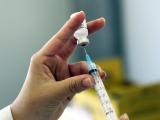England's human papillomavirus (HPV) vaccination program is linked to dramatically lower rates of cervical cancer and precancerous lesions in all socioeconomic groups, reveals a study led by Queen Mary University of London researchers.
For the observational study, published yesterday in BMJ, the researchers analyzed the effect of the country's school-based HPV vaccination program on the incidence of cervical cancer and grade 3 cervical intraepithelial neoplasia (CIN3) in English women aged 20 to 64 years from January 2006 to June 2020. The cohort included 29,968 diagnosed as having cervical cancer and 335,228 with CIN3.
The aim was to replicate previous analyses based on National Health Service cancer registry data, add another 12 months of follow-up (July 2019 to June 2020), and investigate vaccination-program effectiveness across levels of socioeconomic deprivation.
"Human papillomavirus (HPV) comprises a family of viruses, a subset of which are responsible for virtually all cervical and some anogenital and oropharyngeal cancers," the study authors wrote. "In England, HPV vaccination was introduced nationally in 2008 and was offered routinely to girls aged 12-13 years, with catch-up campaigns during 2008-10 targeting older teenagers aged <19 years."
Initially, the bivalent (two-strain) Cervarix vaccine was offered before being supplanted by the quadrivalent (four-strain) Gardasil vaccine in 2012. The program was broadened to include boys aged 12 and 13 years in 2019.
84% reduction in cervical cancers
The low rates of cancerous and precancerous cervical lesions and the estimated high effectiveness of the HPV immunization program seen in the previous study continued during the additional year of follow-up among women born after September 1990.
In women offered HPV vaccination at age 12 and/or 13 years, adjusted age-standardized rates of cervical cancer and CIN3 in the extended follow-up period were a respective 83.9% and 94.3% lower than in those never offered HPV vaccination.
HPV vaccination averted an estimated 687 cervical cancers and 23,192 cases of CIN3 by 2020. The highest rates of averted cancer and precancerous lesions were still observed in women living in the most socioeconomically deprived areas, but the vaccination program substantially reduced rates in women at all five levels of deprivation.
For example, the greatest number of cervical cancer cases were prevented in women in the most-deprived areas (192 and 199 cancers prevented in the first and second fifths of deprivation, respectively) and the fewest in women in the least-deprived fifth (61).
Prevented cases of CIN3 were greatest among women in the more deprived areas (5,121 and 5,773 for first and second fifths, respectively, compared with 4,173 and 3,309 in the fourth and fifth fifths, respectively.
In women offered catch-up vaccination, rates of CIN3 fell more in the least-deprived areas than the most-deprived areas (respective reductions of 40.6% vs 29.6% and 72.8% v 67.7% for women offered vaccination at ages 16 to 18 and 14 to 16 years). "The strong downward gradient in cervical cancer incidence from high to low deprivation in the reference unvaccinated group was no longer present among those offered the vaccine," the researchers wrote.
In a Cancer Research UK news release, senior author Peter Sasieni, PhD, of Queen Mary University, said, "In the UK, the elimination of cervical cancer as a public health problem in our lifetime is possible with continued action to improve access to vaccination and screening for all."
HPV vaccine uptake low in many countries
In a related commentary, Trisha Amboree, MD, MPH, of the University of Texas MD Anderson Cancer Center in Houston, and colleagues noted that poorer women shoulder a disproportionate burden of cervical cancer incidence and death in high-, middle-, and low-income countries.
This finding suggests that marginalized groups may benefit from the HPV vaccine despite poor social determinants of health or higher prevalence of risk factors such as smoking, alcohol consumption, and reduced uptake of cancer screening.
"Interestingly, vaccine effectiveness (the proportion of cervical cancers averted) was consistent regardless of socioeconomic status," they wrote. "This finding suggests that marginalized groups may benefit from the HPV vaccine despite poor social determinants of health or higher prevalence of risk factors such as smoking, alcohol consumption, and reduced uptake of cancer screening."
The findings also underscore the importance of reaching the 90% HPV vaccination uptake goal recommended by the World Health Organization: "Currently, HPV vaccine coverage is below target in many countries despite being offered for several years," they said.
"Inequities in vaccine access, hesitancy, and variation in the extent to which healthcare providers recommend vaccination create a major challenge to target attainment in countries with existing HPV vaccine programmes," they added. "Additionally, upstream factors (finances, health system capacity, supply, and vaccine prioritization) can deter introduction and scale-up in countries with no programmes."
Amboree and colleagues urge collective efforts of government, community stakeholders, and healthcare professionals in these countries to work together to eliminate cervical cancer inequalities. "An equity driven approach is critical for the success of HPV vaccination programmes," they wrote.

















